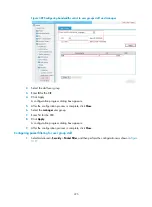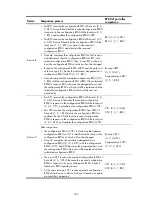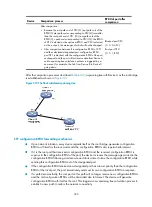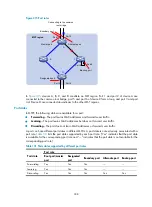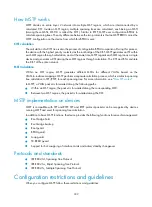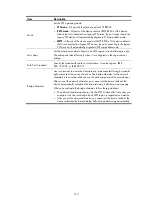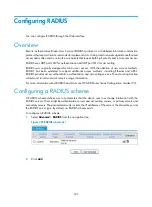
307
For example, in region D0 in
, the regional root of MSTI 1 is device B, and that of MSTI 2 is
device C.
Common root bridge
The common root bridge is the root bridge of the CIST.
In
, for example, the common root bridge is a device in region A0.
Boundary port
A boundary port is a port that connects an MST region to another MST region, or to a single
spanning-tree region running STP, or to a single spanning-tree region running RSTP. It is at the boundary
of an MST region.
During MSTP calculation, the role of a boundary port in an MSTI must be consistent with its role in the
CIST. However, this is not true with master ports. A master port on MSTIs is a root port on the CIST. For
example, in
, if a device in region A0 is interconnected to the first port of a device in region
D0 and the common root bridge of the entire switched network is located in region A0, the first port of
that device in region D0 is the boundary port of region D0.
Port roles
MSTP calculation involves the following port roles: root port, designated port, master port, boundary port,
alternate port, and backup port.
•
Root port
—Port responsible for forwarding data to the root bridge.
•
Designated port
—Port responsible for forwarding data to the downstream network segment or
device.
•
Master port
—Port on the shortest path from the current region to the common root bridge,
connecting the MST region to the common root bridge. If the region is seen as a node, the master
port is the root port of the region on the CST. The master port is a root port on IST/CIST and still a
master port on the other MSTIs.
•
Alternate port
—Standby port for the root port and the master port. When the root port or master
port is blocked, the alternate port becomes the new root port or master port.
•
Backup port
—Backup port of a designated port. When the designated port is blocked, the backup
port becomes a new designated port and starts forwarding data without delay. A loop occurs when
two ports of the same MSTP device are interconnected. The device will block either of the two ports,
and the backup port is the port to be blocked.
A port can play different roles in different MSTIs.
Summary of Contents for MSR SERIES
Page 17: ...xv Documents 835 Websites 835 Conventions 836 Index 838 ...
Page 20: ...3 Figure 3 Initial page of the Web interface ...
Page 42: ...25 Figure 13 Firefox Web browser setting ...
Page 59: ...42 Figure 27 Checking the basic service configuration ...
Page 73: ...56 Figure 35 Sample interface statistics ...
Page 156: ...139 Figure 139 Rebooting the 3G modem ...
Page 168: ...151 Figure 152 Configuring Web server 2 ...
Page 174: ...157 Figure 158 Configure the URL filtering function ...
Page 242: ...225 Figure 233 Enabling the DHCP client on interface Ethernet 0 1 ...
Page 247: ...230 Figure 236 The page for configuring an advanced IPv4 ACL ...
Page 255: ...238 Figure 241 Advanced limit setting ...
Page 298: ...281 e Click Apply 2 Configure Router B in the same way Router A is configured ...
Page 400: ...383 Figure 387 Verifying the configuration ...
Page 405: ...388 ...
Page 523: ...506 Figure 530 Ping configuration page ...
Page 775: ...758 Figure 785 Configuring a jump node ...



